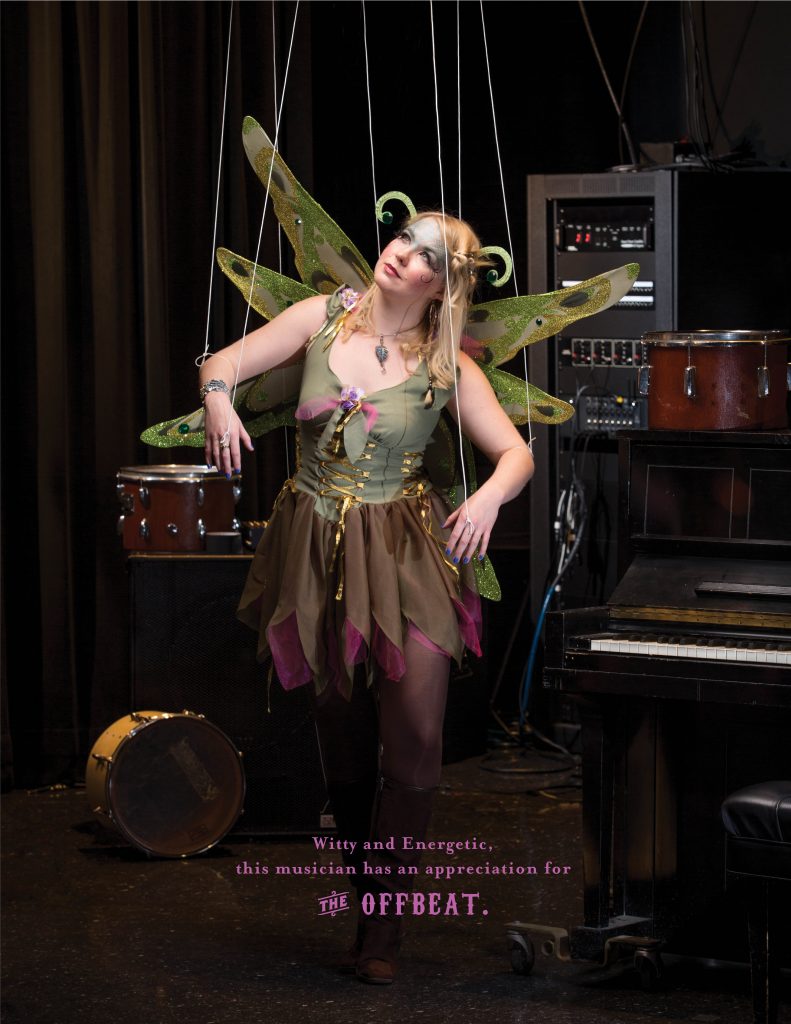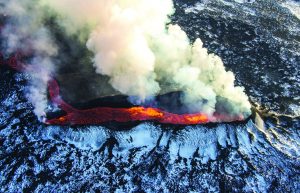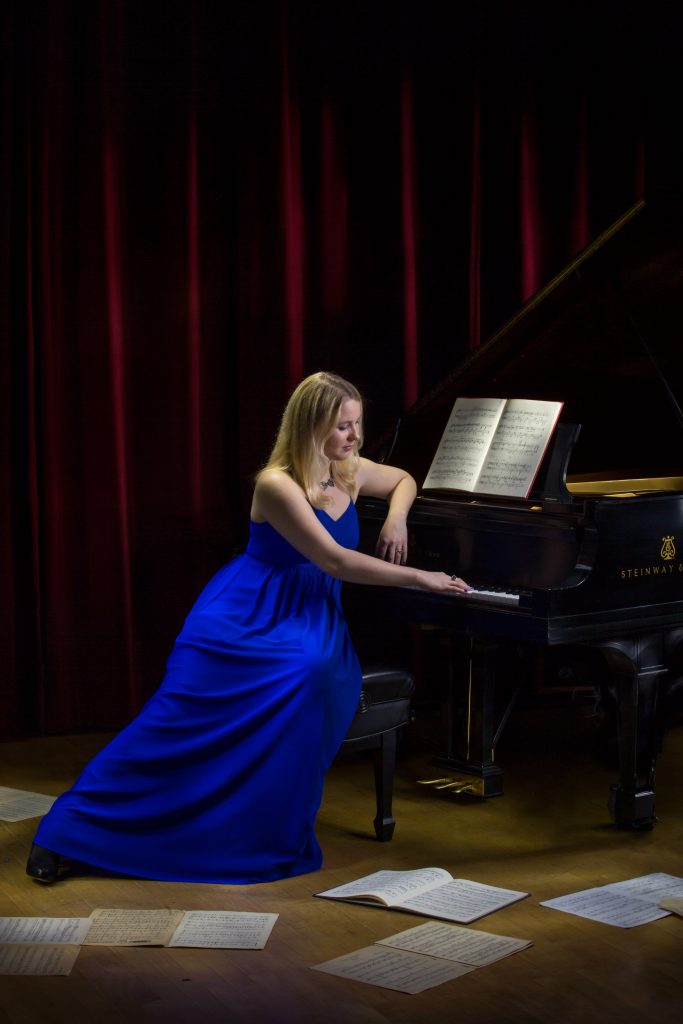Hanna Lisa Stefansson at Play in a World of Fire and Ice
By: Cynthia Adams | Photos By: Nancy Evelyn
Icelandic Roots Sink Deeply into Georgia Clay,Informing the Art of a Macon-Born Performer.
Composer and musician Hanna Lisa Stefansson is a first-generation American from Macon, Ga.,
whose parents are Icelandic. She looks like the prototypically serious musician, one who can
carry off a formal evening gown for a recital, then confesses those closest to her know her by the moniker, “Honsta Monsta.”
She leans over with laughter before recovering and composing herself. “Most of my siblings and friends call me some version of that. I don’t know if that encapsulates a monster-like aspect of me…or what?”
Wait—monster? Stefansson doesn’t mind the nickname. If anything, she enjoys the playfulness of it. She readily confesses to imagining herself working on The Muppets, or doing comedy on Saturday Night Live. “To be improvisational and quick witted,” she explains, “would be a joy.” Then, she positively twinkles with pleasure.
Stefansson possesses a fondness for funk and informality. Her northern/southern hybrid background contributes to her freewheeling creativity. Stefansson is the youngest of four
children. Although only two were born in the U.S., they are all Icelandic speakers—although “Honsta Monsta” has no direct translation, she cracks. It is a dubious gift from her brother,
she adds. “He’s now a lawyer in Atlanta, but he plays guitar.”
She comes from a family who valued music and the arts. Many of her family members were or are musicians, who played organ, violin, guitar, banjo, or accordion. “We have a distant relative who was an opera singer.”
Being fanciful and open minded was encouraged—which is why innovation is a place where Stefansson is easily drawn. Her sister entered the film industry. K. H. Kim, a UGA alum
and creativity expert, explains how the Stefanssons created a setting for creative expression. “Innovators’ parents are nonconformists themselves; and they encourage children to be comfortable with marginality and being an outsider.” The Stefanssons, Icelanders in the South, imported that quality along with a global view.
Experiencing Iceland also fostered imaginative work, Stefansson eagerly explains. “The landscape of Iceland is so extreme and raw; the volcanic lava and fire, the ice and glaciers and the meeting of the two. It’s very dramatic and violent.” She adds that seeing it would help one to understand the creative tensions prevalent in Icelandic folklore and their national stories. The drama of the place inspired fanciful stories and ideas.
“You can see why the elves and dwarves and trolls are a belief in their mythology…if you went there, you would too,” she explains. Stefansson has spent extensive time in Iceland experiencing these raw environmental extremes that fed her Imagination.

Iceland is also among nations where the citizens are rated the happiest. Again, this illustrates the creative duality and resilience cited in Kim’s writings. Stefansson’s favorite childhood book happens to be one I also own and value. It is titled, Lady Cottington’s Pressed Fairy Book.
“I totally believed in fairies, trolls, and the supernatural world—and still do! So, this book was like a beautiful disaster,” she says playfully. This is hardly a mainstream title. Otherworldly and beautiful, it is straight out of the Victorians’ obsession with the fanciful and imagined.
Stefansson is trained in piano, and earning a doctorate in composition with a minor in musicology. Although she isn’t trained in percussion instruments, she “loves playing the piano percussively. You can pluck the inside strings of a grand piano.” After finishing her work next year she says, “I would like to teach composition and music theory. And right now, my dream is to do surround sound for a puppet show, and for film.”
“Atlanta has a center for puppetry arts, and they have an experimental puppet theater event,” which also drove her creative development. Stefansson gives an exclamation of pleasure discussing the genius of Jim Henson’s puppetry work. She mentions her desire to create “an adult puppet show,” and cites other influences such as David Bowie. “It may be on an adult theme, maybe with some smoke machines and lasers.” Her eyes widen. “I live for unique experience.”
Working with an Atlanta music recording studio led Stefansson to immersion performance. “When I decided to go into music composition, I took three years off after college (in 2005) and was recording other people’s music. It was a good experience.” It confirmed she would rather make her own music and a love for “quadraphonic music, which is surround sound in a traditional setting.”
Her dissertation performance this February will employ nontraditional techniques she embraces. It will not be on a traditional stage. Stefansson’s musical compositions are typically performed in a black box at the Hugh Hodgson School of Music. “It’s called the Dancz Center for New Music, says Stefansson. “My dissertation will be my first to incorporate dancers.”
Iceland, said place of fire and ice, possesses a surreal landscape which Stefansson raptly describes. The extremes there are a creative touchstone for Stefansson, who frequently
returns to her family’s home of Reykjavik. Her heart drops slightly each time she leaves—it is a world apart. “Iceland is more progressive. They had the first female president in the western world. Iceland’s lesbian prime minister was the world’s first openly lesbian head of government. Women have a lot more equality there,” she says.

Iceland is a volcanic island located in the North Atlantic Ocean. The main island is roughly the size of Virginia. Icelandic landscapes are shaped by the forces of nature and vary from deep fjords to vast volcanic deserts, with black sand beaches, snowcapped mountains and staggering waterfalls. Iceland’s nature remains mostly unspoiled as the island is sparsely populated. Of the 320,000 citizens, two-thirds live in the capital Reykjavík. Iceland’s population is young, with close to 40% under the age of 18.
Her father, Sturla Stefansson, is a retired anesthesiologist, who did his residency at Yale. Her mother, Herdis Herbertsdottir, is a graphic designer and artist. “They came to Macon, Ga., thinking it was for a year.” Her oldest sister, Silja, was born in Iceland. Her brother, Sturla Freyr was born in Connecticut. Hanna Lisa and her sister, Lilja, were both born in Macon. In the family home, music was, and is, always playing. “I knew I wanted to be involved in music, but I didn’t know in exactly what,” she shrugs.
David Bowie is often playing in Stefansson’s Athens apartment, or electronic music “that is fun and dancey.” She likes Led Zeppelin, Bjork, Stravinsky and Bartok. “The mix is interesting,” she says, when she creates a playlist.
“Composition people have listening parties,” she explains.
“That is something that occurred in my Master’s program at Georgia State. I need to bring that back and have composers do that at Georgia! We play something we’re listening to and have something we’re experimenting with.” Music informs her spare time, when she enjoys playing on a digital piano, listening to music, or record shopping.
As for her upcoming dissertation performance next spring, Stefansson says she no longer has stage fright. Once she was the shy one, but no longer. “I used to get very nervous in high school and college. I had to ‘face the music’, pun intended, to get over it.”
She is rightly focused upon this culminating work, which is an electroacoustic piece. To blend electronic and acoustic music, Stefansson uses prerecorded music with live acoustic instruments, including percussion, violin, and woodwind. There will be three dancers for the 25 minute performance and she works with a choreographer to help plan costumes and lighting.
“The basic concept is ritual,” she explains. “So, instead of using religion, I’m using the natural elements–earth, water, air, fire. So the arc of the piece is the individual elements represented by the dancers, who come together to create a ritual. Other aspects are undertones of the piece—such as technology influencing nature.”
She is also influenced by her dreams, and it is a great pleasure when she is aware of a theme or dreamscape, Stefansson says dreamily. “If not a musician, I might have become involved in music therapy,” she says. She wears a face of contentment; a smile is about to break.
“According to Ruut Veenhoven’s database of happiness, Iceland consistently ranks as one of the happiest countries in the world. In some surveys, it ranks number one,” writes Eric Weiner in Geography of Bliss. And its happiest, most musical ambassador is one named Hanna Lisa.









